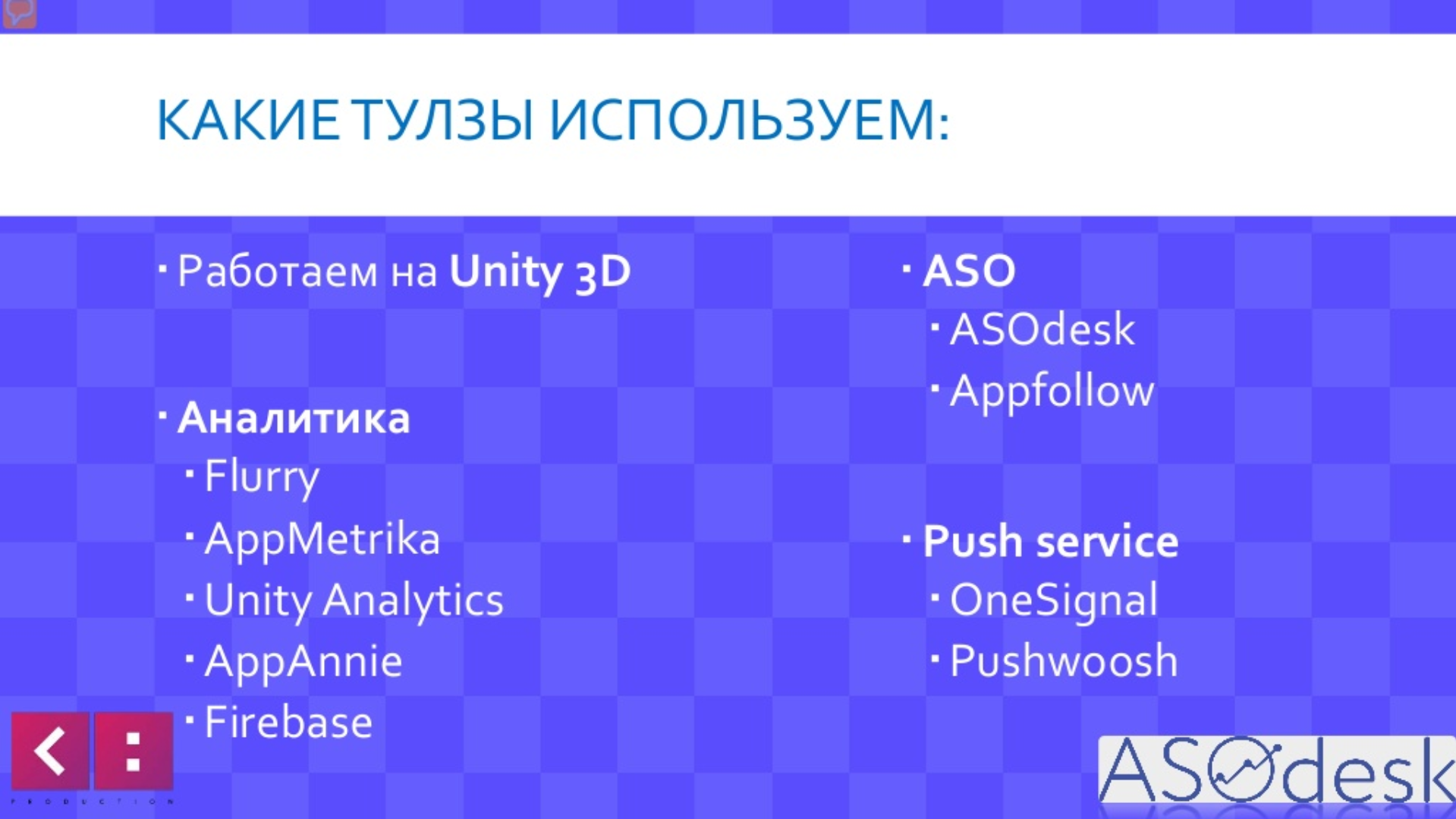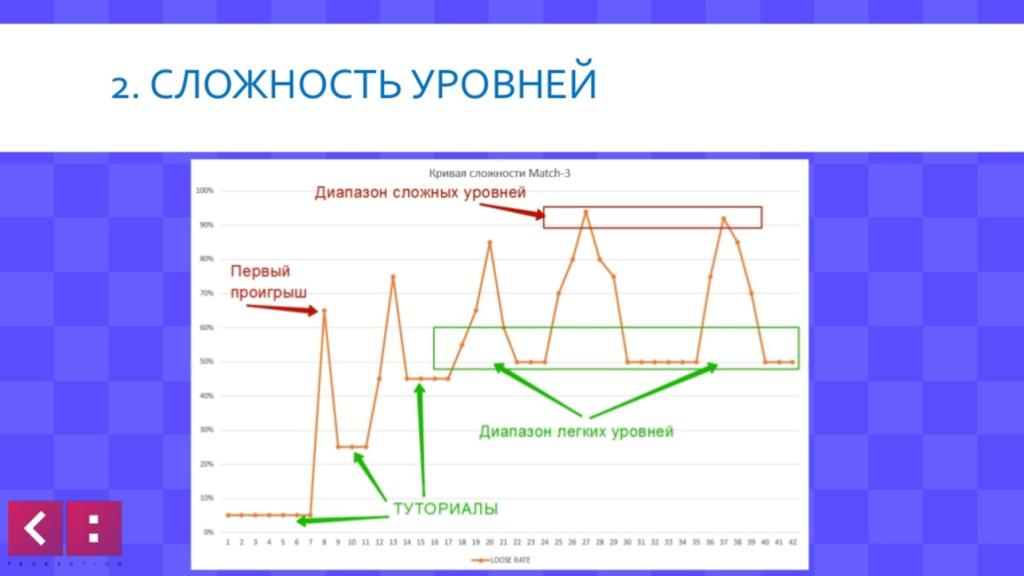10 tips for working on games in the Match-3 genre: a guide from KB Production
How to adjust the balance in games in the genre of three-in-a-row, how to approach the placement of chips on the field, what can be the level editor for such games? Vitaly Kozlov, the founder of KB Production, answers these and other questions.
The report was read at White Nights St.Petersburg 2017. We have prepared a printed version of the speech.

Vitaly Kozlov
We started as developers of children’s games. At some point we had interesting projects: projects with MTS, Fixiki. They even filmed a separate series for one of our games. But we decided to make money on the development of “three-in-a-row” games.
We have chosen such a niche for ourselves as a “three-in-a-row” with popular, well-known brands.

Our idea is that we make a “three-in-a-row” game, focusing on a children’s brand, for example, “Masha and the Bear”, but at the same time we focus on parents. For moms 35+. This approach is through the “Trojan horse”, through children to their mothers.
We work on Unity 3D, there are about 10 people in our team, and I think our experience will be interesting to people who are going to do “three-in-a—row” or are already doing them – small or medium-sized companies.
When we started making the first “three-in-a-row” game, we had a lot of questions. We tried to find some answers, but, unfortunately, there was very little information on the market. In principle, even now I don’t see any overabundance of information specific to “three-in-a-row” from those who develop them.
Our questions were typical for those who do “three-in-a-row”. How to make a balance? How to test? How many levels do I need? When to start? How to choose mechanics and how often to add them?
I will try to tell you what answers to these questions we have found.
1. What should be the first step in developing a three-in-a-row?
First of all, this advice from the Captain: choose a “three-in-a-row” game on the market, and preferably not one that best suits what you have planned to do, because you do not need to invent bicycles. If someone has already come up with something, you need to see how it was implemented before you.

I don’t urge you to copy blindly, but the players for whom you will make your game will later compare your game with competitors themselves. Therefore, start comparing yourself, figure out how it is done by competitors and how it will be implemented by you.
2. How to make a three-in-a-row balance?
At the beginning of the game, everything should be simple, without difficulties, because you are teaching the player. You need to teach him, you do not need to immediately dump a difficult level on him, but you should not keep away from difficulties for a long time.
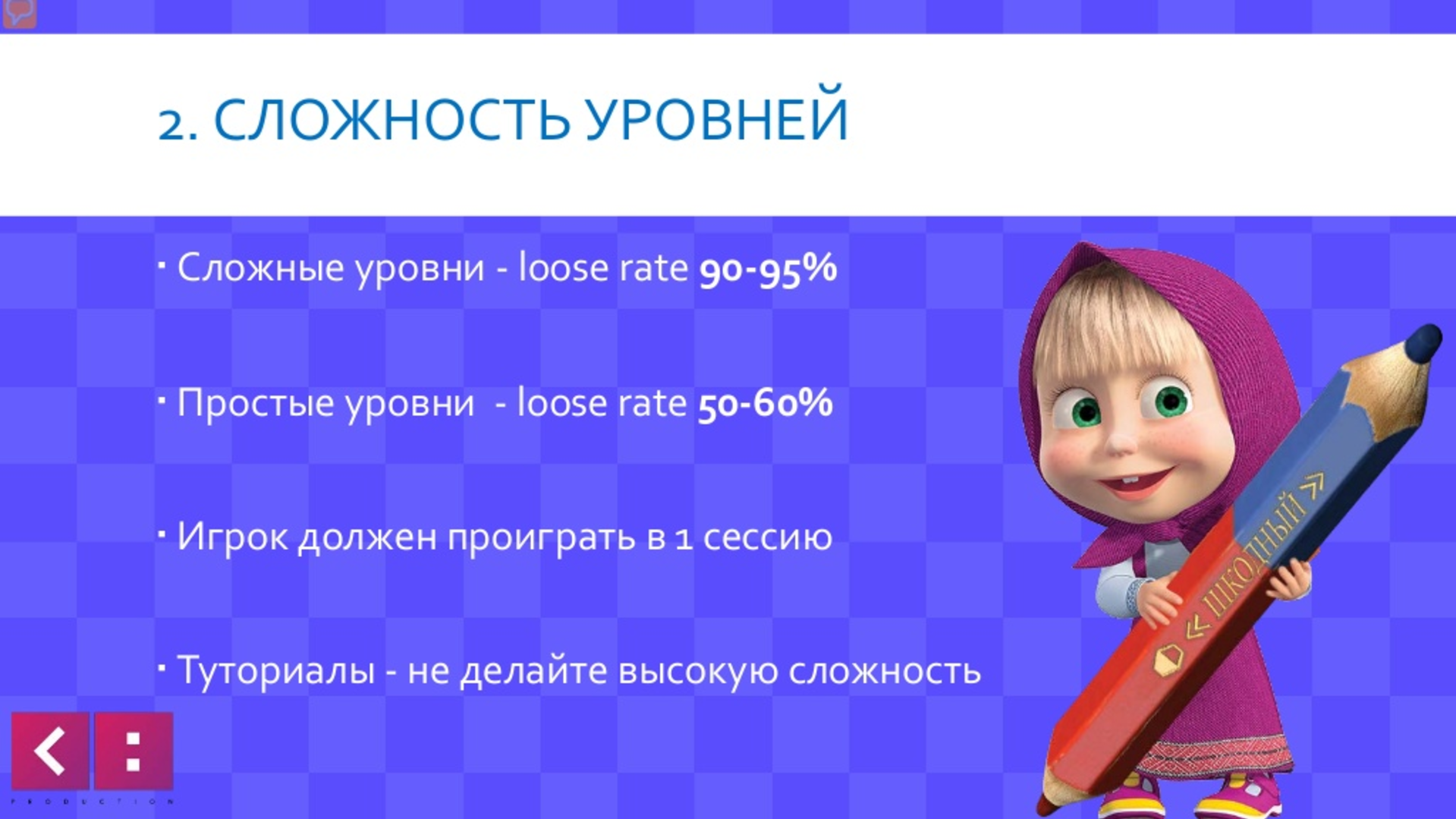
The first peak of difficulty we have is level 8. It falls on the first session.
The first session must necessarily be with a difficult level, so that the player does not think that everything is very simple.
Then there are simple levels.
We made a mistake: we made simple levels too simple. It turned out that the player “flew” them very quickly, they did not cause him any emotions, no sensations. Therefore, try to do simple levels approximately in the range of 50-60% difficulty. It’s not that difficult for the player, it’s a few attempts, but he feels that he won for a reason, even though he didn’t get stuck for a long time at these levels.
We usually get difficult levels in the range of 90-95%.
This is how our level designers usually have a complexity curve:
Sometimes we can go to the peak of complexity gradually, or we can go out abruptly. We can abruptly leave the peak of complexity, or we can gradually leave.
3. How often do I need to add new mechanics?
At the start, when you have a shortage of them, you add new mechanics often enough, every 3-5 levels, until you get enough of them to mix and the levels are not repetitive and of the same type. About 5-6 mechanics are enough for this.
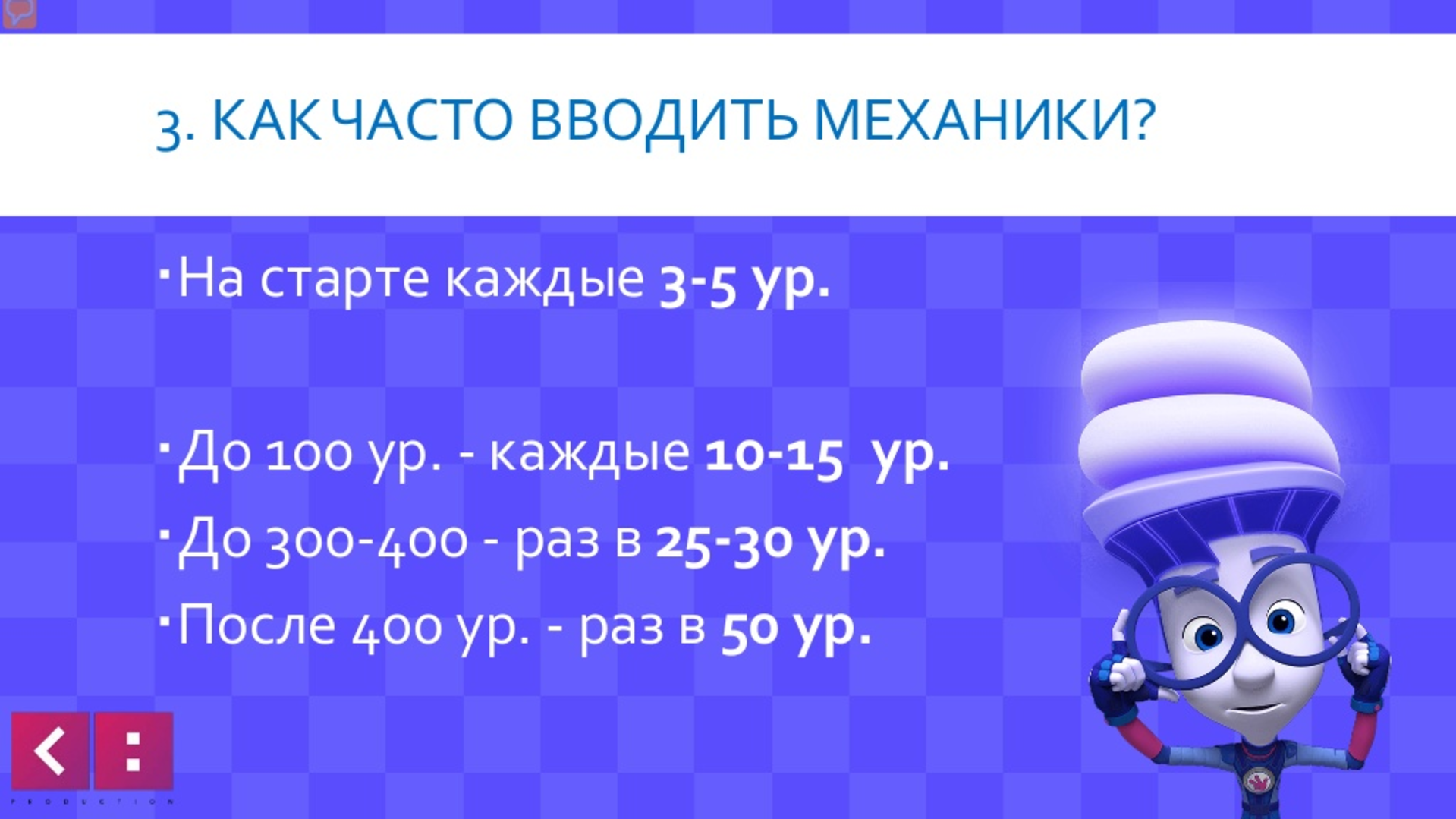
Then, up to level 100, we make a range of 10-15 levels by adding one new mechanic. Further – up to 300-400 levels – the range increases to 25-30. There are a lot of them, it becomes possible to alternate them from level to level more actively. After 400-500 levels, mechanics can be set even less often, about once every 50 levels.
You should not put the same type of mechanics in a row, still try to make them diverse.
4. How should the chips be placed on the field?
The question is often raised whether a static arrangement is needed at the start of the game or a random one?
We need random. According to our feelings, this works better, because if we are talking about a difficult level that a player replays many, many times, then he constantly encounters this level. He has a problem, he can’t win it. And when he sees the same arrangement and tries the first move, the second move, variations of moves, and they do not help him succeed, he thinks that you are deceiving him, he thinks: “Ah, you deliberately set such an arrangement so that I do not win!” Therefore, when there is random, and the player, starting the level, sees a different arrangement, this gives him the opportunity to think that now he will come up with the right move or he will be lucky with the arrangement, and he will definitely win it.
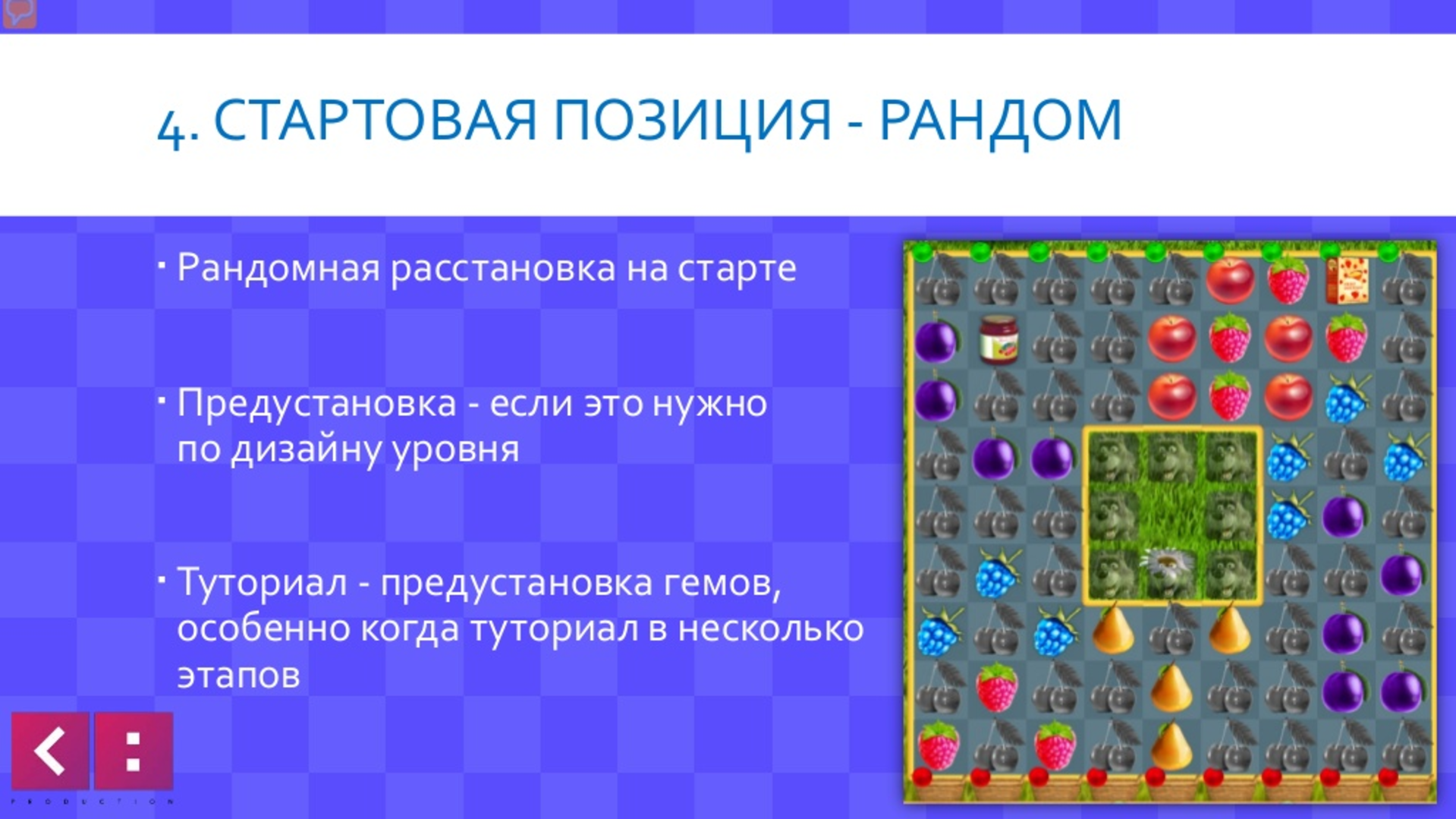
Preset is allowed depending on the mechanics of the level. If, for example, delivery is needed, and you want there to be obviously a good move first, so that the product falls down, then there may be several such presets. You can mix them so that they don’t catch your eye. You can make 3-4 presets, if you need them for some reason, and periodically run them randomly. This will solve your problem, and the player will think that everything is random again.
Well, the tutorial, of course. If you are doing a tutorial of levels, and you have multi-stage, 2-3 moves in the tutorial, then there is a preset needed, because you are leading a person through certain steps, there is no way without it.
5. How many moves should there be on the level?
How do we choose how many moves to put on a level? It’s a question of balance, a question of complexity. We try to bet in the range of 20-30 moves. Sometimes 35 is allowed.
Why so, and not otherwise?
Too many moves suggests a longer session. If we are talking about a difficult level, then we generally try to go along the lower boundary, — relatively speaking, 20 moves. We try to get closer to this, because the player replays a difficult level many times. And it should be dynamic. Even if he loses, there has to be a drive. If you make a lot of moves, and the level is difficult, long, then the player, replaying it many times, starts to get bored, sad and leaves.
If we are talking about a simple level, then there you can go to the upper limit of the number of moves. Because we know that he will pass it quickly, he will not replay it, but nevertheless you need him to spend a certain amount of time in the game and get his fan doing the same grinding. We understand that he will pass this level, collect his matches and then not return to it, but we make 30-35 moves, we try to go to the top bar. So avoid short sessions so that there are no levels that are too fast.
6. How many colors should the chips be on the level?
We have from 4 to 6 colors on each level. Most often there are chips of 5 colors at the levels: this is the most balanced option.
For difficult levels, and difficult from the point of view of the configuration of the field (for example, the presence of blockers on this field), we try to use 4-5 colors; 4 — rarely, 5 — often.
The formula here is quite simple: the more complex the configuration, the fewer colors you need, because if you use a large number of colors, you will have frequent reshuffles (reshuffle, automatic rearrangement of chips on the field in the absence of move options, — approx. editorial offices). Reshafly is evil, the player does not like them.

The picture shows an example of a complex level in terms of configuration, and here, as you can see, there are fewer colors, 6 — this will be evil at all. It will be uninteresting to play, there will be forced matches, you will force the player to make a forced move, the only one available on the field. This is also bad. Do not force the player to make forced moves, give him the opportunity to choose.
Actually, the number of colors is one of the ways to balance the level, which allows you to avoid such forced moves.
Test results
Why am I telling all this so confidently? Why am I telling you that this is the way to do it, and not in another way?
These are the results of our own tests. We lost quite a lot of time by initially making a different balance in the game.
Introducing a new balance, we did A/B testing. Thanks to this, as a result of the innovations, we found out that we received a 73% increase in the number of payments. Our income has grown by 50%.
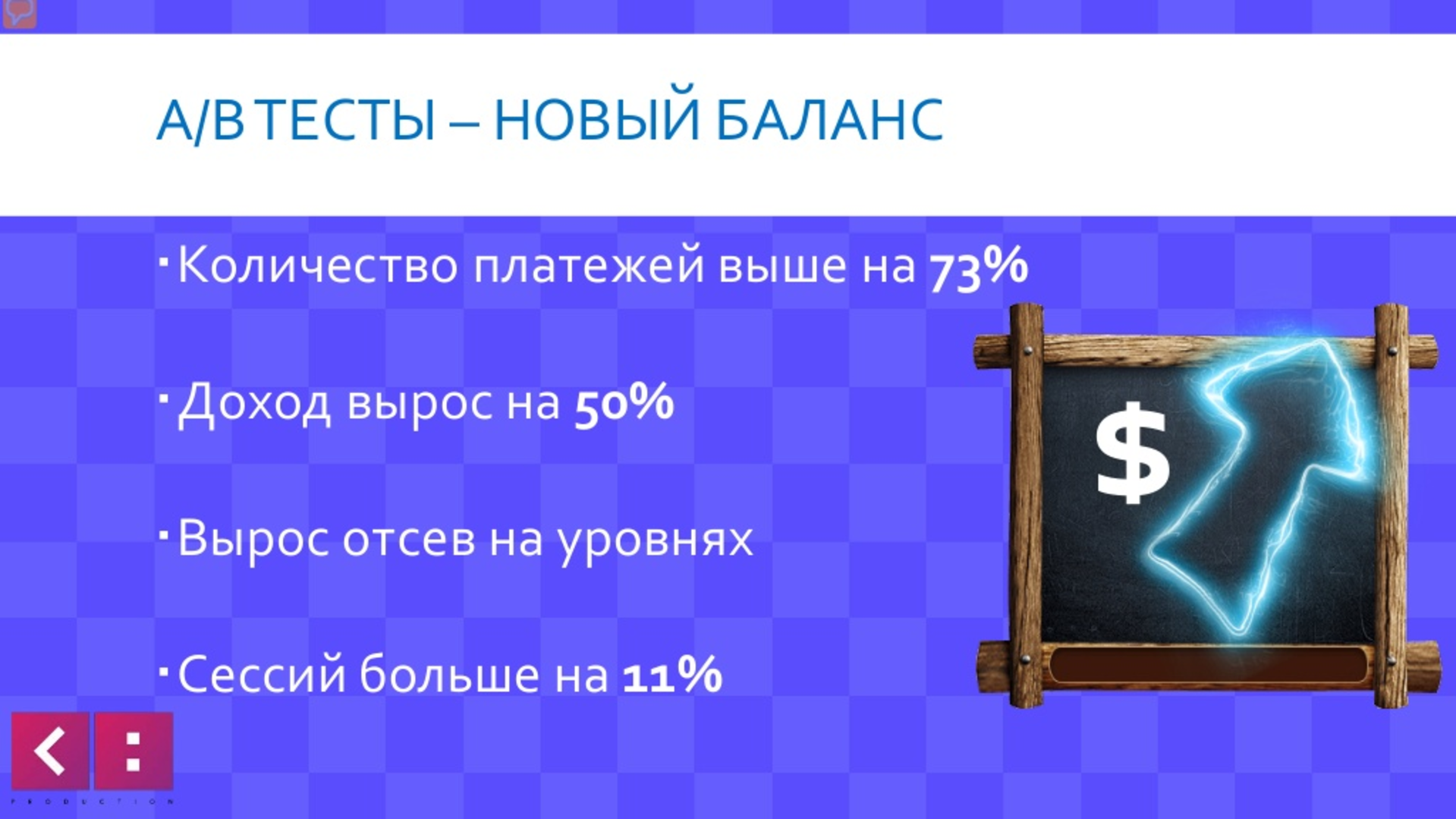
Yes, at the same time, of course, we received a higher outflow of players, because we have tightened the simple levels in complexity to 50-60%. But at the same time, we lowered paywalls from exorbitant numbers to 90-93, on average, rarely – 95. And, on the one hand, we got more players at low, starting levels, but on the other, we got such numbers that justify it.
The most interesting thing is that the number of sessions increased by 11%, despite the fact that fewer players unlocked the levels. That is, they began to play more. More often.
7. How is it possible to conduct testing?
We have a bot. He’s a bit dumb. But it plays the basic mechanics well and allows us to make the first “target” assessment of the created levels. He can quickly win back 300-500 attempts, and we use this data as a starting data for ourselves. Again, we have some correction factors. When we compare how the level created and balanced by us “enters” a specific player, we can then enter a coefficient, how the bot plays and how a live person plays the same level. Having this coefficient, we bring the bot’s data a little closer to reality. This allows you to make a “targeted” assessment of a new level.
Then, of course, the second stage we will definitely play the level with “hands”. If someone made levels and passed them a lot in their “three-in-a-row”, then after playing five to ten times a level, he already understands the complexity of this level.
And, of course, the third stage is the main one — you get data from real players, and based on this data you adjust the levels. And you need to do it quickly.
We have the opportunity, for example, to adjust the levels directly from the server, that is, there is no need to restart the game. Such an obvious thing, maybe. But if you see that you got a level not of the complexity that you wanted, you can quickly fix it. This is very convenient, especially if we are talking about paywalls, about difficult levels at which excesses can occur, which is why you start having too serious dropout of players. It’s a pity to weed out the players: they are very expensive.
8. How to check the level?
The slide below lists the basic rules by which we check the levels created by the level designer.
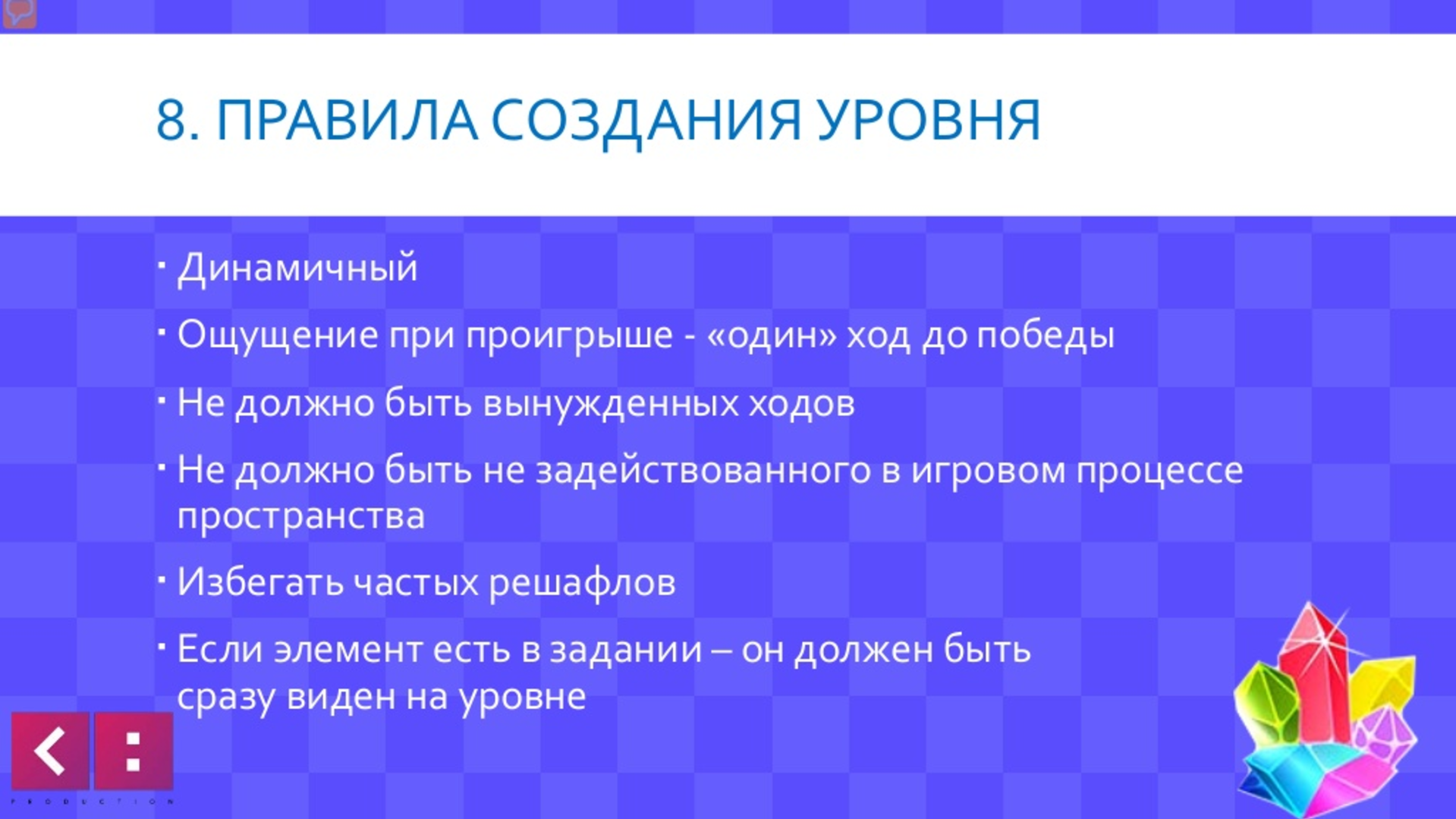
First of all, the level should be dynamic, because the player should be interested.
We try to make sure that even when a person loses, he remains with the feeling that he just didn’t have enough to win. This seriously provokes him to pay money. It is extremely difficult to achieve this, but nevertheless try, at least, to avoid situations when, when losing, the player sees that victory is almost unattainable for him. This is the greatest evil.
If you cannot balance the level so that there is a feeling of one move, at least avoid situations where there is a feeling that it is unrealistic to win this level until the end of the turn and it is not worth even trying.
Avoid forced moves. A player should always be able to choose two or three combinations so that he feels that he decides how the situation on the field develops further, that he chooses this combination and not another.
If you have made a level in which there is some piece of unused space that does not participate in the gameplay one way or another – most likely, this is the wrong balance of the level. It shouldn’t be like this. Everything that is on the field, all the pieces of the field that you have decided to make, must somehow be involved in the gameplay. Otherwise, why do you make them?
Avoid frequent reshuffles, because frequent reshuffles distract a person from the game, knock him off a certain pattern.
If there is an element in the task, for example, you need to collect some kind of butterfly on the field, then this butterfly should appear immediately on the first move. Do not make it so that if the task is to collect a butterfly, then the game begins, but there is no butterfly on the field, and it appears only on the second move. Immediately, all the elements that you gave in the task should be on the field.
Level Editor
What is a convenient editor? This is primarily — and most importantly — your level creation speed.
In fact, you need to do something that allows you to access the main elements in one click when creating levels. A good example is Photoshop: you choose a brush and start drawing a field with it, placing gems on this field, and so on.
Maybe things that are obvious to someone, but nevertheless, for example, we could not find any prototypes when we tried to make our own editor, and we lost a lot of time on this.
More tips about the editor: visualize the settings hints. For example, we have visualized the starting points from where the gems are generated, and the stop points below which the gems do not fall. This will allow you to quickly catch bugs that may occur during the creation of levels.
In our case, this optimization of the editor allowed us to increase the number of levels that one level designer creates per working day to 10-15 levels. Of these, about 3-4 levels are difficult, 6 are simple. This is our speed with which we can make levels.
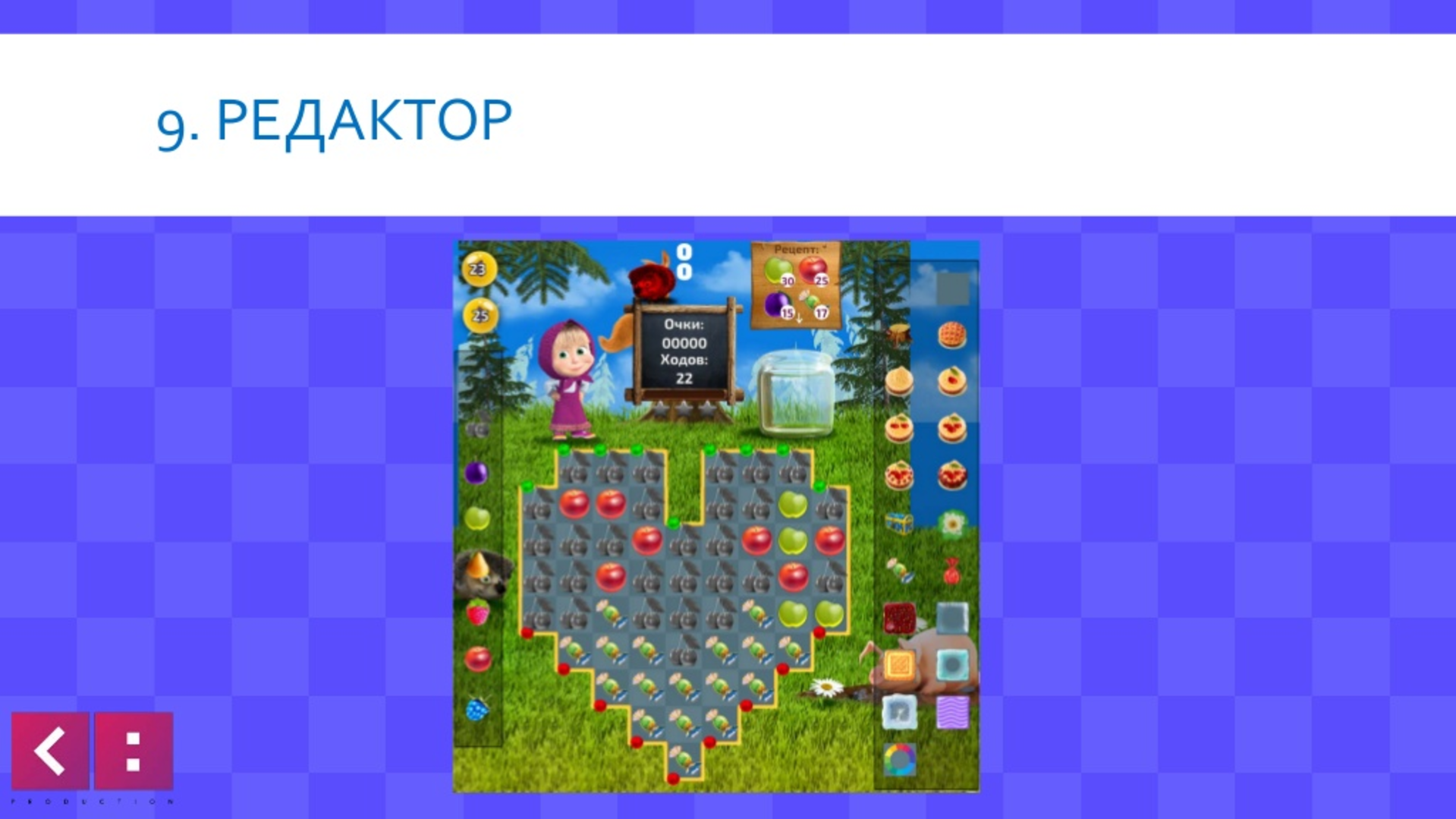
On the slide just above is our editor. From right to left, the elements are basic, the field can be changed quickly, these green dots are spawn points, red dots are the points where the boundaries end, below which the gem can no longer fall. Cherries are random. And everything else is already a preset.
9. How many levels should there be?
Have you started making a three-in-a-row game and want to understand for yourself, decide when it is finally possible to release it? Do you need to make 100 levels, 300 or even 1000, like the best representatives of this genre?
I can say that if you have content for a month of the game, then this is a sufficient amount of content with which you can already go out. Moreover, you need to leave as early as possible, because you will receive feedback from the player and you will no longer do abstract things in the game, but will do it looking back at the real data from the game. This is a big plus, of course.
But at the same time, you should understand that if you launch the game “into battle”, you should be ready to immediately make bugfixes, because you will certainly have them. Then it will be necessary to make bugfixes after your bugfixes, with which you will probably also add bugs, and at the same time you should have time to add enough levels once a week or once every two weeks, in the worst case, so that the game develops in front of the player, and at the same time those who have reached the level cap, we received a new batch of levels, and could play them for the next week while you make new ones.
When you don’t have enough levels, when you hit the level cap, re-use the previously created levels, because you can turn simple levels into complex ones by upgrading them a little. This is, relatively speaking, the day of the game designer’s work. Or let those players who have reached the level-cap, replay them again, adding some goal, prizes. As you like, it depends on you.
10. Do I need three-in-a-row advertising?
The question of advertising is complicated. On the one hand, I want more money, and on the other hand, I don’t want the game to lose some of its appeal because of advertising, users began to leave.
We answered it positively for ourselves. We started using rewarded advertising. In this case, the player decides for himself whether to watch the advertisement or not, whether he wants to receive any bonus for viewing or not. This allows you to monetize those regions where they pay little.

We had doubts. We were afraid that advertising could lead to both a drop in retention and a decrease in the number of payments.
In fact, it turned out the opposite: the retention became higher, and they began to pay more.
We explained it for ourselves as follows: you give the player an easy opportunity to try premium things. When he has already got used to the fact that there are additional moves that he receives for advertising, or some other things – life there, then at some point he can convert into a payer. Therefore, it is rather more good than evil, especially in our case, when we do not impose advertising on anyone. I wanted to turn it on — turned it on, I wanted to turn it off – turned it off.
So we are happy with our experience in advertising.
Analytics
There is no such thing as a lot of analytics. Log everything you can! Even if you don’t need it now, when some brilliant idea visits you, you will be able to dig up the statistics you typed earlier and make the selection that will answer your questions that you will have later.
The main points should, of course, be recorded in the game. It is especially important to think through analytics when you are preparing A/B tests, because any A/B test needs to be evaluated.
We had cases when it seemed that we had pledged everything we needed for A/B-test analytics, and then it turned out that we had not taken into account one item, and all our testing that we conducted went nowhere, because one element was missing, and we couldn’t draw conclusions.
Well, when you do several tests, keep in mind that they do not overlap: data can affect each other.
Community
Just below is one of these obvious, but necessary slides.
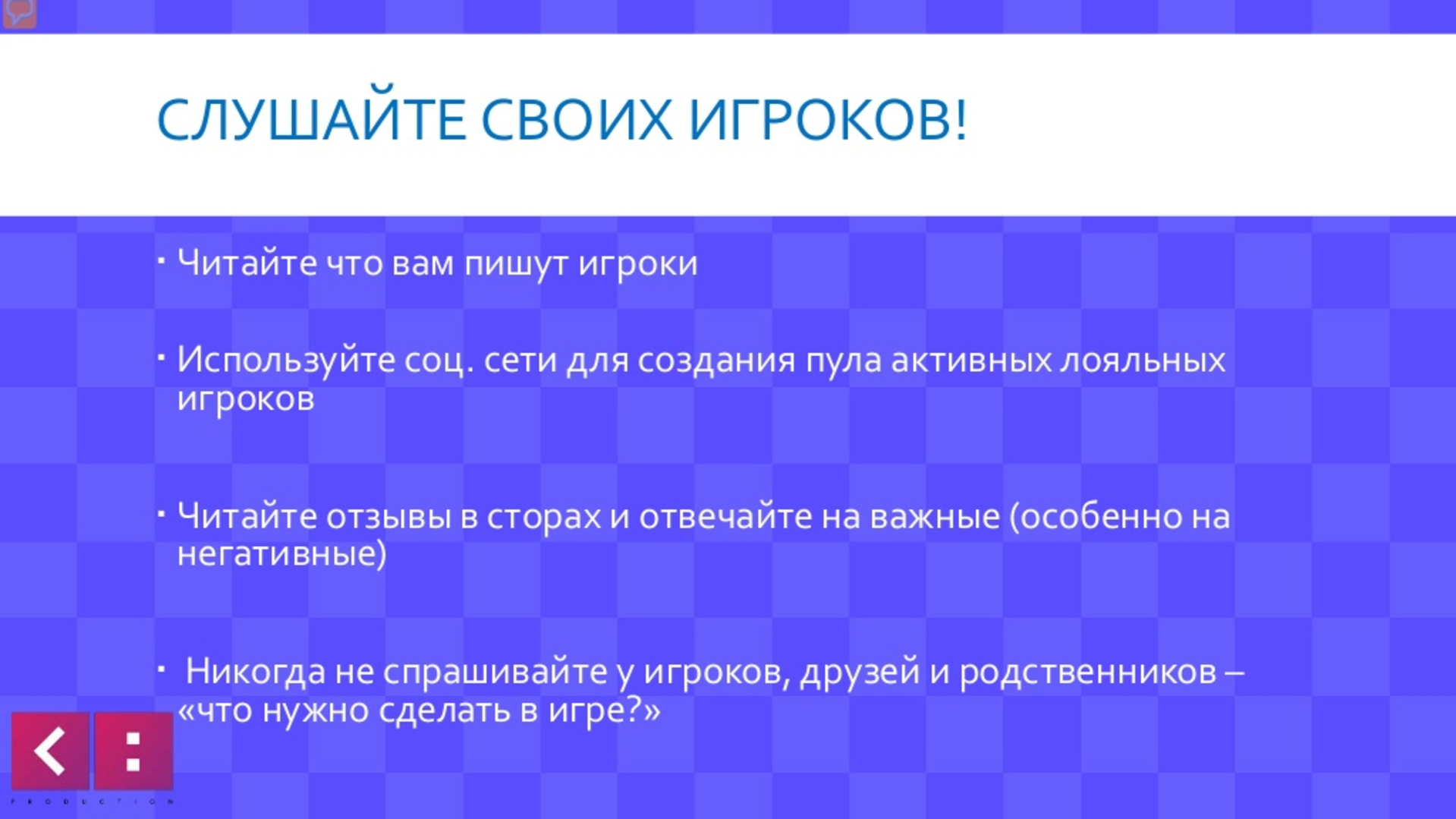
This thing solved a lot of our problems: communicate with players, try to create a community of some loyal players, communicate in social networks, communicate in the mail, read reviews, respond. This will help you find bugs faster than any analytics you will be watching. That’s why it’s important, try to aggregate them.
What do we use?
Here is a list of programs that we use.
